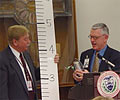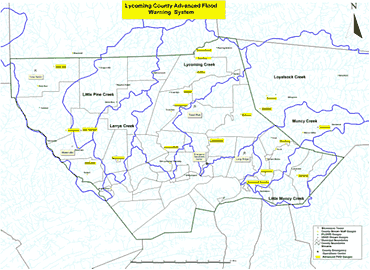Advanced Flood Warning System (FWS)
| Current Rainfall Data for Lycoming County, Pennsylvania |
| |
 |
| Gary Hutchinson, Director of Department of Public Safety displays Williamsport Sun Gazette January 20, 1996 headline depicting aftermath of the devastating flood. |
| |
 |
| Jerry Walls, Director of the Lycoming County Economic Development and Planning Services Department speaks to how the automated Flood Warning System fits into the County Mitigation strategy. |
| |
 |
| Michael Conway, Director of Waterways Engineering, PA Department of Environmental Resources, worked as a partner to help develop and fund this system. |
| |
 |
| Edward Burke, Director of Central Region PEMA highlighted the sustained effort and partnerships necessary to bring this system to success. |
| |
 |
| Peter Jung, Service Hydrologist for the NOAA/National Weather Service, discussed the uses for the gage data after it is collected. |
| |
 |
| Major Eric McFadden, Acting Deputy District Engineer for Support Operations, Baltimore District, US Army Corps of Engineers, officially dedicated the new automated Flood Warning System. |
| |
 |
| Rebecca A. Burke, Chairperson of the Lycoming County Commissioners, commended legislators, partners and staff in “getting the job done”. |
| |
 |
| Richard T. Nassberg, Vice-Chairman of the Lycoming County Commissioners, noted the continued support that Lycoming County has received from all levels of government. |
| |
 |
| Commissioner Burke presents a commemorative plaque to Philip Hager, Planning Studies/Project Manager, Baltimore District, US ACE. |
| |
 |
| Gary Hutchinson presents a replica of a staff gage to Jerry Walls who exchanges it for a state of the art ultra-sonic canister. |
Williamsport, Lycoming County, January 20, 2004
The Board of Commissioners for the County of Lycoming have announced the installation of the County’s new Flood Warning System. This multi-year project was funded in partnership with the US Army Corps of Engineers and the Pennsylvania Department of Environmental Protection.
The new flood warning system consists of twenty geographically dispersed stream gages. In addition, nine of the twenty sites also have rainfall gages installed as well. Three types of stream depth gages have been employed in the state-of-the-art system: “pressure transducer,” “ultrasonic,” and “read out equipment for USGS Sites”. The gages send a Very High Frequency (VHF) signal to the County’s four mountaintop microwave towers. Flood Warning System equipment has been installed on County microwave towers to convert VHF signals to microwaves, which are then retransmitted to the County’s Emergency Operations Center (EOC) and its 9-1-1 Center. New computers have been installed in both the EOC as well as the 9-1-1 Center to receive incoming Flood Warning System results.
New gages, installed on the five major creeks of Pine, Larry’s, Lycoming, Loyalsock, and Muncy, are strategically located to maximize the warning time to downstream communities across the County. The emergency management staff at the EOC will now have a much more complete picture of stream conditions on these five “flashflood-prone” creeks. The gages were designed to be compatible with the State’s Integrated Flood Observation Warning System (IFLOWS), thus Lycoming County data can be automatically retransmitted to the Pennsylvania Emergency Management Agency to assist communities downriver of Williamsport. The system provides continuous, 24-hour coverage, regardless of weather and time of day.
“Several thousand of our residents live in the vulnerable floodplains along these streams”, commented Commissioner Rebecca Burke. “This new system will enable the County to provide local emergency management coordinators additional time to notify and warn residents and businesses alike – potentially saving lives and reducing damage to property.”
The expected increased warning time ranges from 1.5 hours to 3.2 hours depending on the “flashiness” of the creek. US Army Corps of Engineers calculated an extremely favorable Benefit to Cost Ratio (BCR) for this project of 17.8 to 1. “In other words, for every $1 spent to construct the project, $17.80 of property will be protected from flood damages—that is real value added,” said Commissioner Dick Nassberg.
With the operation of the automatic system, volunteer “staff gage” readers will no longer have to go out into risky areas. There should also be a decreased need for volunteer fire and rescue personnel to be in harm’s way to rescue citizens since those residents will now be provided additional warning time.
The system was designed and installed as a joint project of the Lycoming County Economic Development and Planning Services, the Lycoming County Department of Public Safety, the United States Army Corps of Engineers Baltimore District, and the PA Department of Environmental Protection, Bureau of Waterways Engineering. In addition to these partners, Lycoming County would like to acknowledge the cooperative efforts of the Pennsylvania Department of Transportation, United States Geological Survey, Bureau of State Parks, Department of Conservation and Natural Resources, Pennsylvania Emergency Management Agency, National Oceanic and Atmospheric Administration/National Weather Service, and Union Township in Tioga County.
Lycoming County held a ceremony today to dedicate the system and commemorate the installation of the County’s Advanced Flood Warning System. Speakers include: Major Eric McFadden, US Army Corps of Engineers; Michael Conway, Director of Waterways Engineering, PA Department of Environmental Protection; Edward J. Burke, Director of the Central Region, Pennsylvania Emergency Management Agency; Peter Jung, NOAA/NWS; Lycoming County Commissioners Rebecca A. Burke and Richard T. Nassberg; Gary Hutchinson, Director of the Lycoming County Department of Public Safety; and Jerry S. Walls, Director of Lycoming County Economic Development and Planning Services. The event was held at the County’s Department of Public Safety.
January 19, 2004 was the eighth anniversary of the 1996 flood, which resulted in six deaths, 88 hospitalizations, and 200 people being treated and released. This devastating event caused extensive property damage: 1,418 homes damaged—674 destroyed or heavily damaged, 160 businesses damaged—1,000 jobs at risk, 1,500 vehicles destroyed, $6,000,000 in flood hazard mitigation assistance, $24,000,000 in property tax exonerations, and $25,000,000 in disaster relief expenditures. The Flood Warning System is designed and constructed to offer additional warning time so that lives may be saved and property loss may be reduced.
 |
| Map of the the Lycoming County Advanced Flood Warning System |